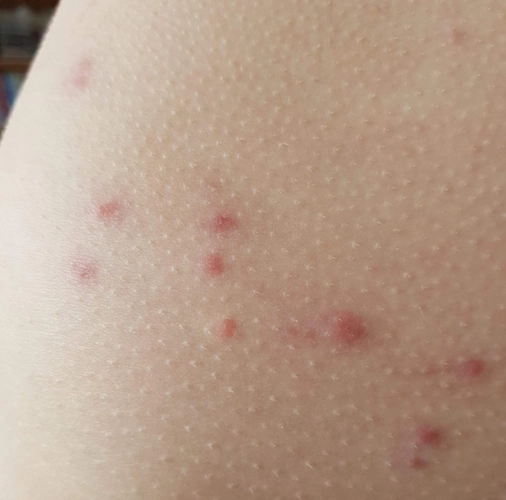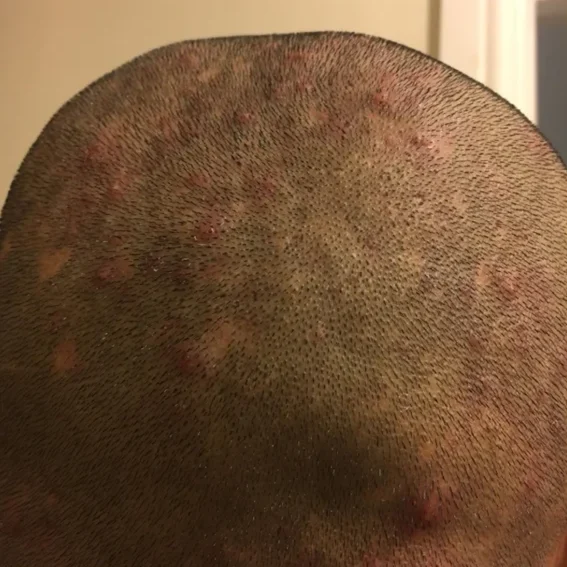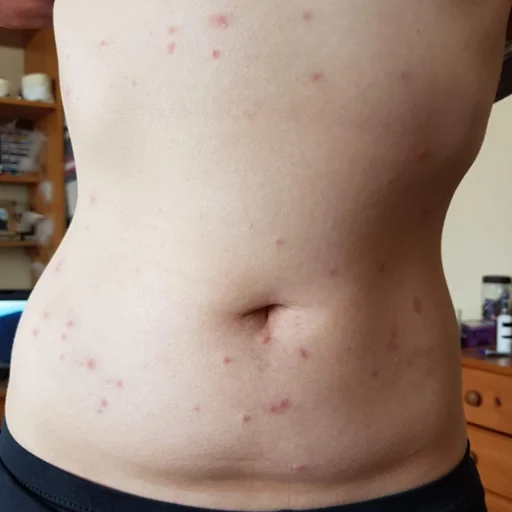What is folliculitis?
Folliculitis is the name given to inflammation of the hair follicles, which results in red, tender spots, often with pustules on the surface of the skin. It can affect anywhere where hair grows, such as the back, chest, buttocks, arms and legs.
What are the different types of folliculitis?
Folliculitis has different names depending on which sites it affects:
It can affect anywhere where hair grows. It can affect the beard area, causing folliculitis barbae, sycosis barbae and pseudofolliculitis. Malassezia folliculitis, pseudomonas folliculitis, non-infective folliculitis, disseminate and recurrent infundibulofolliculitis are types of folliculitis that affect the trunk and buttocks. There are different types of folliculitis that affect the scalp, including scalp folliculitis, folliculitis decalvans, dissecting cellulitis and acne keloidalis nuchae.
For more information on the individual types of folliculitis, please see the following link-
http://www.pcds.org.uk/clinical-guidance/folliculitis-an-overview


What does folliculitis look like?
Folliculitis can be classed as superficial or deep, depending on how far down in the skin the follicle is affected. Superficial folliculitis usually presents with multiple small spots and pustules, on an inflamed base, pierced by a central hair, although this might not always be visible. Deeper lesions present as painful, often pustular, inflamed lumps. Persistent or recurrent lesions may result in scarring and permanent hair loss.
How is the diagnosis of folliculitis made?
Folliculitis is usually diagnosed clinically by examining your skin. A swab may be taken from any pustules to check for infection. Occasionally other tests are required, for example if a fungal infection is suspected, scrapings and affected hairs can be sent for fungal testing. If you have recurrent deep, painful lumps, your doctor may suggest a blood test to check your full blood count and sugar levels.
Treatments for folliculitis
The first thing to do would be to manage any causative factors. Patients receiving topical treatments for other skin conditions, such as eczema, may require their treatment modifying for example changing to a lighter emollient regime for a while.

Minor cases
If folliculitis is thought to be related to shaving and other hair-removal techniques, the only certain cure is to stop shaving for a period of about three months or longer, however this is not always possible.
If shaving is necessary then the recommendation would to aim for a stubble length of 1 mm. If you shave too close, this can cause the hair to retract inside the follicle, and if the hair is left too long, it can curl back and pierce the skin.
An electric razor is best, but if using a wet shave you should use a single blade, shave in the direction of the hair growth and avoid stretching the skin tight. You should shave every second day, rather than daily if possible.
Mild cases
Mild cases may resolve without treatment. If staphylococcal infection is present, you may require a topical anti-septic or antibiotic treatment, such as dermol®, chlorhexidine or topical clindamycin gel. More deep-seated or persistent lesions require antibiotic tablets. If there is recurrent infection, a swab of the nose is likely to be done to test for any carriage of staphylococcus, which can then be eradicated with mupirocin nasal ointment (bactroban ®).
Some mild topical steroids can be useful for areas of inflammation, but are best avoided if infection is the cause. Antibiotics with an anti-inflammatory role, such as lymecycline, used for spells of 6-12 weeks can be beneficial
Severe cases
In more severe cases, Isotretinoin, given in a specialist dermatology clinic, is sometimes used.
Phototherapy may benefit some patients with chronic, non-infective folliculitis.
More information about folliculitis
Links to websites with more information:
http://www.pcds.org.uk/clinical-guidance/folliculitis-an-overview
https://www.dermnetnz.org/topics/folliculitis/



